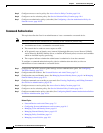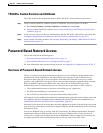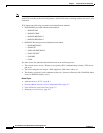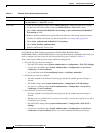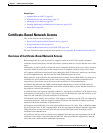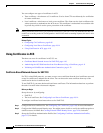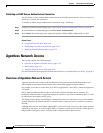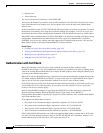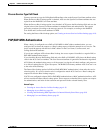
4-12
User Guide for Cisco Secure Access Control System 5.3
OL-24201-01
Chapter 4 Common Scenarios Using ACS
Agentless Network Access
Validating an LDAP Secure Authentication Connection
You can define a secure authentication connection for the LDAP external identity store, by using a CA
certificate to validate the connection.
To validate an LDAP secure authentication connection using a certificate:
Step 1 Configure an LDAP external identity store. See Creating External LDAP Identity Stores, page 8-26.
Step 2 In the LDAP Server Connection page, check Use Secure Authentication.
Step 3 Select Root CA from the drop-down menu and continue with the LDAP configuration for ACS.
Related Topics
• Using Certificates in ACS, page 4-10
• Configuring Local Server Certificates, page 18-14
• Managing External Identity Stores, page 8-22
Agentless Network Access
This section contains the following topics:
• Overview of Agentless Network Access, page 4-12
• Host Lookup, page 4-13
• Agentless Network Access Flow, page 4-16
For more information about protocols used for network access, see Authentication in ACS 5.3, page B-1.
Overview of Agentless Network Access
Agentless network access refers to the mechanisms used to perform port-based authentication and
authorization in cases where the host device does not have the appropriate agent software.
For example, a host device, where there is no 802.1x supplicant or a host device, where the supplicant
is disabled.
802.1x must be enabled on the host device and on the switch to which the device connects. If a
host/device without an 802.1x supplicant attempts to connect to a port that is enabled for 802.1x, it will
be subjected to the default security policy.
The default security policy says that 802.1x authentication must succeed before access to the network is
granted. Therefore, by default, non-802.1x-capable devices cannot get access to an 802.1x-protected
network.
Although many devices increasingly support 802.1x, there will always be devices that require network
connectivity, but do not, or cannot, support 802.1x. Examples of such devices include network printers,
badge readers, and legacy servers. You must make some provision for these devices.



